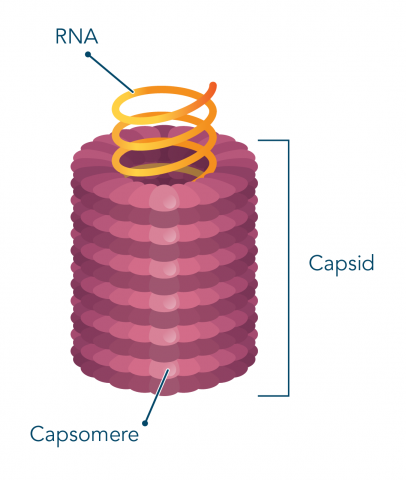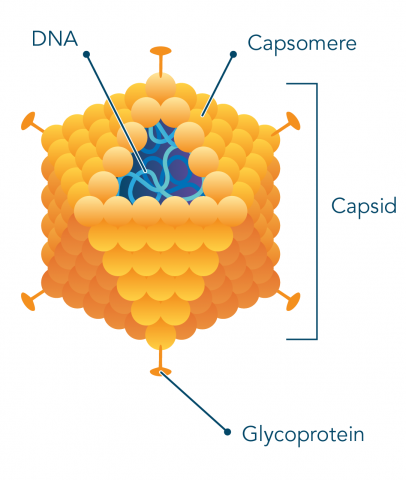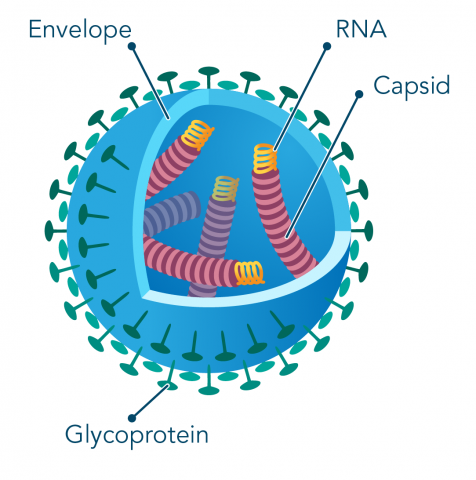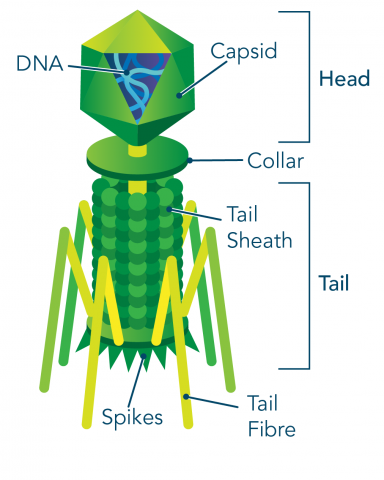Introduction to Viruses
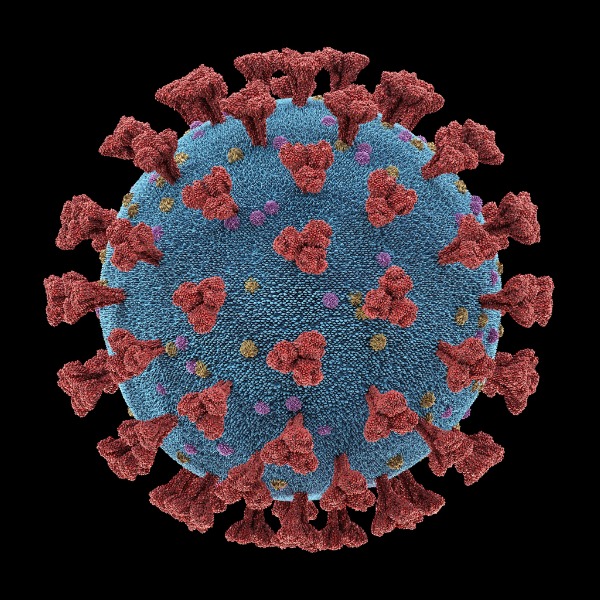
Coronavirus (ktsimage, iStockphoto)

Coronavirus (ktsimage, iStockphoto)
How does this align with my curriculum?
Learn about the basics of viruses.
Viruses have a big impact on humans. Coronavirus 2019 (COVID-19), the common cold, the flu, Severe Acute Respiratory Syndrome (SARS) and diseases like Acquired Immunodeficiency Syndrome (AIDS) are all caused by viral infections. Scientists have worked for hundreds of years to understand viruses and find better ways of fighting them.
Virus Structure
Viruses are very small. They are usually 17 to 400 nanometres in diameter. A human hair is much larger - about 80 000 nanometres wide. Even bacteria are about 100 times larger than viruses.
Because viruses are so small, they have simple structures. They are much simpler than animal or bacterial cells. Viruses have three basic parts:
Click here to access screen-reader friendly PDF
Even though they only have a few parts, viruses come in many different shapes. Pictures of viruses can look like creatures out of science fiction. Some have heads that are polyhedrons, or many-sided three-dimensional shapes. These are connected to little jointed shapes that look like legs. Other viruses look like round popcorn. Like bacteria, they can be classified based on their shape.
Viruses are classified into four main categories:
Helical viruses: These look like long rods. They can be rigid or flexible. The helical virus below is a tomato mosaic virus. It causes the leaves and fruit of tomato plants to appear blotchy.
Image - Text Version
Shown is a colour illustration of a hollow purple cylinder with a gold corkscrew shape inside. The cylinder shape is ribbed with a bumpy texture. The whole structure is labelled "Capsid." One of the bumps is labelled "Capsomere." The corkscrew shape inside looks like a spring made from gold wire. This is labelled "RNA."
Polyhedral viruses: These are many-sided viruses. Their capsids can have different numbers of sides. Most have 20 triangular sides and 12 vertices, or corners. The polyhedral virus below is the adenovirus. It causes respiratory illnesses.
Image - Text Version
Shown is a colour illustration of a gold polyhedron with blue, stringlike structures inside. The walls of the outside shape are made from small gold spheres. The whole shape is labelled "Capsid." One of the spheres is labelled "Capsomere." Each corner of the polyhedron has a thin stick with a small disc on the end. These resemble gold thumbtacks. One is labelled "Glycoprotein." One triangular wall of the polyhedron is open to reveal the tangled structures inside. These look like thin tangled strings. They are labelled "DNA."
Enveloped viruses: These are shaped like spheres and have a protein, fat or carbohydrate coat over their capsid. Coronaviruses are a type of enveloped virus.
The COVID-19 pandemic is caused by a virus like this. So is influenza. SARS and Middle East Respiratory Syndrome (MERS) are also caused by enveloped viruses. The image below shows an influenza virus. It causes respiratory illnesses like coughs and sore throats.
Image - Text Version
Shown is a colour illustration of a blue sphere with green structures on the outside and curved, tube-like shapes inside. The sphere is smooth and hollow with thick walls. This is labelled "Envelope." The outside surface is dotted with small green sticks with discs on the ends. One of these thumbtack-like structures is labelled "Glycoprotein." Inside, short pink and red striped tube shapes float. One of these is labelled "Capsid." Each capsid is hollow with a gold spring or corkscrew-shaped structure inside. One of these is labelled "RNA."
Complex viruses: These have complicated structures. Their capsids can be attached to structures that look like legs. These are called tail fibres. The virus to the right is a bacteriophage. It infects bacteria.
Image - Text Version
Shown is a colour illustration of a green structure that resembles a faceted head on a cylindrical body with long, bent legs. Starting at the top, the first part of the structure is a green polyhedron. This is labelled "Capsid." One triangular wall of this shape is open to reveal a tangle of blue string-like shapes inside. These are labelled "DNA." This whole section is labelled "Head." The head sits on top of a thin yellow stem. This is surrounded by a wide ring labelled "Collar." Below, the rest of the whole structure is labelled "Tail." This includes a number of smaller structures. The stem from above leads into the centre of a hollow cylinder made of small green spheres. This is labelled "Tail Sheath." Six long, thin, green tubes extend up from the bottom of the sheath, then bend sharply back to the ground. These resemble spiders' legs and are labelled "Tail Fibre." The bottom edge of the tail sheath is trimmed in triangular green shapes. These are labelled "Spikes."
Are Viruses Living Things?
Scientists are not sure if viruses are alive or not. They do not share many of the characteristics of living things.
They do not have cells. They have DNA or RNA, but they do not have a cell membrane or organelles.
They cannot make their own energy. In other words, they don’t have a metabolism. A metabolism is all the chemical reactions an organism needs to live.
They cannot reproduce on their own. They must live inside a host cell to make more viruses. Hosts can be bacterial, plant or animal cells.
They do not use energy on their own. Viruses only use the energy of their host cells. They are inactive before they come into contact with them. Some bacteria also work this way.
They don’t really respond to their environments. Viruses interact with their host cells to infect them, but they don’t do too much more.
How do Viruses Reproduce?
Whether they are living or not, viruses can reproduce. This is what happens in your body when you have a viral infection. The virus uses your cells to replicate itself. This process is often called the virus life cycle. The steps in this cycle are illustrated below.
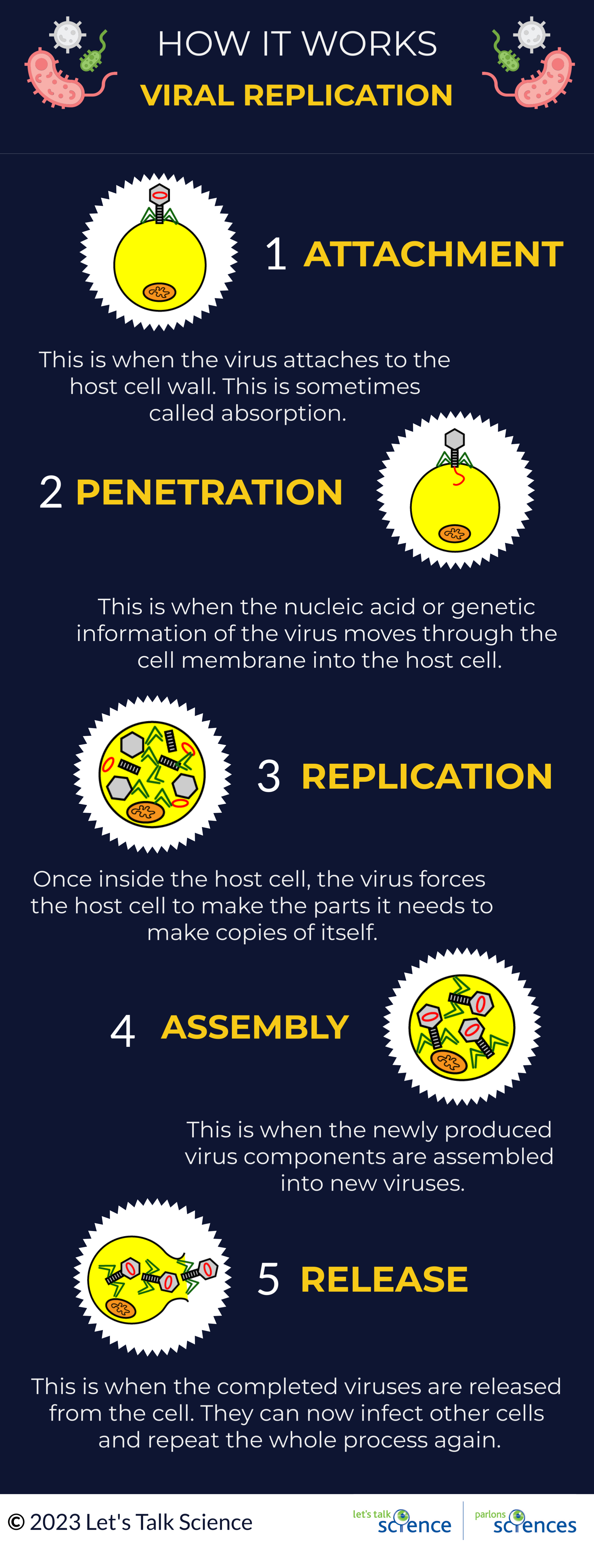
Viral Life Cycle (©2023 Let's Talk Science)
Image - Text Version
Shown is a colour infographic with illustrations of the five stages of viral replication. Across the top is the title "How it Works: Viral Replication." This is bracketed by little illustrations of viruses. The first heading reads, "1 Attachment." Beside it is an illustration of a complex virus sitting on top of a yellow sphere with a small red oval inside. The text below reads, "This is when the virus attaches to the host cell wall. This is sometimes called absorption." Below, the second heading reads, "2 Penetration." In this illustration, a thin red string-like shape reaches from the bottom of the virus into the top of the cell. The text reads, "This is when the nucleic acid or genetic information of the virus moves through the cell membrane into the host cell. The third heading reads, "3 Replication." In this illustration, the virus is no longer sitting on top of the cell. Now there are three virus heads, three tail sheaths and six tail fibres floating around inside it. The text reads, "Once inside the host cell, the virus forces the host cell to make the parts it needs to make copies of itself." The fourth heading reads, "4 Assembly." In this illustration, three complete viruses float inside the host cell. The text reads, "This is when the newly produced virus components are assembled into new viruses." The last heading reads, "5 Release." In this illustration, the viruses are bursting through the wall of the host cell. The text reads, "This is when the completed viruses are released from the cell. They can now infect other cells and repeat the process again."
Thank you to the Let's Talk Science Challenge volunteer writers who provided content in this backgrounder.
Learn More
Viruses (Updated) (2018)
This animated video (6:48 min.) from the Amoeba Sisters shows the structures of viruses and their life cycle.
This basic introduction to viruses from Khan Academy, explores their structures and life cycle.
Viruses: Molecular Hijackers (2017)
This video (10:01 min.) from Professor Dave looks at the parts of a virus, how viruses infect cells, and how viruses replicate.
References
Freudenrich, C., & Kiger P. J. (2020). How viruses work. HowStuffWorks.
Morgridge Institute for Research. (2020). Virus structure.
Open Text BC. (n.d.). The viral life cycle.
Wagner, R. & Krug, R. (n.d.). Virus. Encyclopaedia Britannica.
